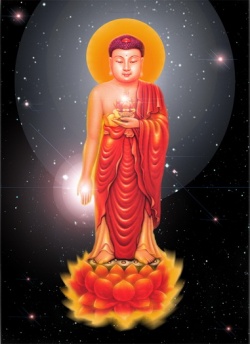Difference between revisions of "Amitabha Origins"
(Created page with "thumb|250px| The first known epigraphic evidence for Amitabha is the bottom part of a 2nd century statue which has been found in Govindnagar, Pakistan, and...") |
|||
| Line 1: | Line 1: | ||
[[File:Amt13.jpg|thumb|250px|]] | [[File:Amt13.jpg|thumb|250px|]] | ||
| − | The first known epigraphic evidence for Amitabha is the bottom part of a 2nd century statue which has been found in Govindnagar, Pakistan, and is now at the Mathura Museum. The statue is dated to "the 28th year of the reign of Huvishka", that is, sometime in the later half of the 2nd century during the period of the Kushan Empire, and dedicated to "Amitabha Buddha" by a family of merchants. The first known sutra mentioning Amitabha is the translation into Chinese of the Pratyutpanna Sutra by the Kushan monk Lokaksema around 180 180 CE. This work is said to be at the origin of Pure Land practice in China. The appearance of such literature and sculptural remains at the end of the 2nd century suggests that the doctrine of Amitabha probably developed during the 1st and 2nd century Common Era CE. | + | The first known epigraphic evidence for [[Amitabha]] is the bottom part of a 2nd century statue which has been found in Govindnagar, {{Wiki|Pakistan}}, and is now at the Mathura Museum. The statue is dated to "the 28th year of the reign of Huvishka", that is, sometime in the later half of the 2nd century during the period of the Kushan [[Empire]], and dedicated to "[[Amitabha Buddha]]" by a family of merchants. The first known [[sutra]] mentioning [[Amitabha]] is the translation into {{Wiki|Chinese}} of the Pratyutpanna [[Sutra]] by the Kushan [[monk]] [[Lokaksema]] around 180 180 CE. This work is said to be at the origin of [[Pure Land]] practice in [[China]]. The appearance of such {{Wiki|literature}} and sculptural remains at the end of the 2nd century suggests that the [[doctrine]] of [[Amitabha]] probably developed during the 1st and 2nd century Common Era CE. |
{{R}} | {{R}} | ||
[http://www.mauspfeil.net/suche.html?key=Amitabha www.mauspfeil.net] | [http://www.mauspfeil.net/suche.html?key=Amitabha www.mauspfeil.net] | ||
[[Category:Buddhist Terms]] | [[Category:Buddhist Terms]] | ||
[[Category:Amitabha]] | [[Category:Amitabha]] | ||
Revision as of 23:51, 3 September 2013
The first known epigraphic evidence for Amitabha is the bottom part of a 2nd century statue which has been found in Govindnagar, Pakistan, and is now at the Mathura Museum. The statue is dated to "the 28th year of the reign of Huvishka", that is, sometime in the later half of the 2nd century during the period of the Kushan Empire, and dedicated to "Amitabha Buddha" by a family of merchants. The first known sutra mentioning Amitabha is the translation into Chinese of the Pratyutpanna Sutra by the Kushan monk Lokaksema around 180 180 CE. This work is said to be at the origin of Pure Land practice in China. The appearance of such literature and sculptural remains at the end of the 2nd century suggests that the doctrine of Amitabha probably developed during the 1st and 2nd century Common Era CE.
